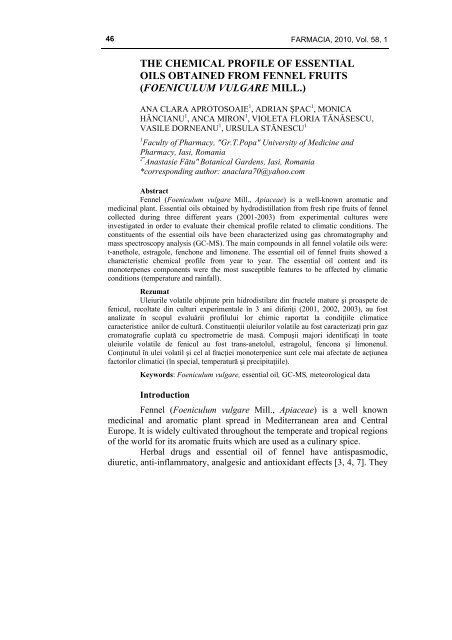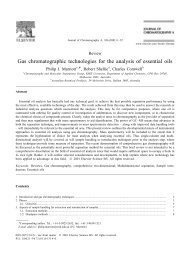the chemical profile of essential oils obtained from fennel fruits
the chemical profile of essential oils obtained from fennel fruits
the chemical profile of essential oils obtained from fennel fruits
You also want an ePaper? Increase the reach of your titles
YUMPU automatically turns print PDFs into web optimized ePapers that Google loves.
46FARMACIA, 2010, Vol. 58, 1THE CHEMICAL PROFILE OF ESSENTIALOILS OBTAINED FROM FENNEL FRUITS(FOENICULUM VULGARE MILL.)ANA CLARA APROTOSOAIE 1 , ADRIAN ŞPAC 1 , MONICAHĂNCIANU 1 , ANCA MIRON 1 , VIOLETA FLORIA TĂNĂSESCU,VASILE DORNEANU 1 , URSULA STĂNESCU 11 Faculty <strong>of</strong> Pharmacy, "Gr.T.Popa" University <strong>of</strong> Medicine andPharmacy, Iasi, Romania2" Anastasie Fătu" Botanical Gardens, Iasi, Romania*corresponding author: anaclara70@yahoo.comAbstractFennel (Foeniculum vulgare Mill., Apiaceae) is a well-known aromatic andmedicinal plant. Essential <strong>oils</strong> <strong>obtained</strong> by hydrodistillation <strong>from</strong> fresh ripe <strong>fruits</strong> <strong>of</strong> <strong>fennel</strong>collected during three different years (2001-2003) <strong>from</strong> experimental cultures wereinvestigated in order to evaluate <strong>the</strong>ir <strong>chemical</strong> <strong>pr<strong>of</strong>ile</strong> related to climatic conditions. Theconstituents <strong>of</strong> <strong>the</strong> <strong>essential</strong> <strong>oils</strong> have been characterized using gas chromatography andmass spectroscopy analysis (GC-MS). The main compounds in all <strong>fennel</strong> volatile <strong>oils</strong> were:t-anethole, estragole, fenchone and limonene. The <strong>essential</strong> oil <strong>of</strong> <strong>fennel</strong> <strong>fruits</strong> showed acharacteristic <strong>chemical</strong> <strong>pr<strong>of</strong>ile</strong> <strong>from</strong> year to year. The <strong>essential</strong> oil content and itsmonoterpenes components were <strong>the</strong> most susceptible features to be affected by climaticconditions (temperature and rainfall).RezumatUleiurile volatile obţinute prin hidrodistilare din fructele mature şi proaspete defenicul, recoltate din culturi experimentale în 3 ani diferiţi (2001, 2002, 2003), au fostanalizate în scopul evaluării pr<strong>of</strong>ilului lor chimic raportat la condiţiile climaticecaracteristice anilor de cultură. Constituenţii uleiurilor volatile au fost caracterizaţi prin gazcromatografie cuplată cu spectrometrie de masă. Compuşii majori identificaţi în toateuleiurile volatile de fenicul au fost trans-anetolul, estragolul, fencona şi limonenul.Conţinutul în ulei volatil şi cel al fracţiei monoterpenice sunt cele mai afectate de acţiuneafactorilor climatici (în special, temperatură şi precipitaţiile).Keywords: Foeniculum vulgare, <strong>essential</strong> oil, GC-MS, meteorological dataIntroductionFennel (Foeniculum vulgare Mill., Apiaceae) is a well knownmedicinal and aromatic plant spread in Mediterranean area and CentralEurope. It is widely cultivated throughout <strong>the</strong> temperate and tropical regions<strong>of</strong> <strong>the</strong> world for its aromatic <strong>fruits</strong> which are used as a culinary spice.Herbal drugs and <strong>essential</strong> oil <strong>of</strong> <strong>fennel</strong> have antispasmodic,diuretic, anti-inflammatory, analgesic and antioxidant effects [3, 4, 7]. They
FARMACIA, 2010, Vol. 58, 1 49
50FARMACIA, 2010, Vol. 58, 1RTCompoundTable IIICompounds identified in <strong>fennel</strong> volatile <strong>oils</strong>Area (%)(min.)2001 2002 20034.30 1,8-cineole 4.29 - -5.04 α-pinen 0.34 - 1.885.13 β-pinen 0.59 - 0.337.74 limonene 0.34 - -6.34 cymene 1.36 - -8.65 limonene 0.34 1.04 1.859.11 γ-terpinene - 0.36 -9.35 camphene - - 0.1610.18 myrcene - - 0.7210.46 α-felandrene - - 0.3410.69 α-terpinene - - 0.0311.08 fenchone 8.56 10.56 13.1211.48 γ-terpinene - - 0.3613.08 camfor - - 0.4113.78 terpinen-4-ol 0.20 - 0.0814.62 estragole 2.53 8.28 2.9914.93 α-terpineol 0.23 - -16.82 t-anethole 60.42 75.81 77.6119.24 p-anisaldehide - - 0.0519.77 2,3,4,6-tetramethyl-phenol - 1.72 -20.22 timol 7.41 - -20.59 carvacrol 12.09 - -RT= retention time (min.)The number <strong>of</strong> compounds identified in <strong>the</strong> three <strong>oils</strong> was different:thirteen (13), six (6) and fourteen (14) were identified, representing 97.77%(2001), 98.36% (2002) and 99.79% (2003) <strong>of</strong> <strong>the</strong> fruit volatile oil. Transanethole,a phenylpropanoid derivative was <strong>the</strong> main compound in all <strong>oils</strong>; o<strong>the</strong>rmajor components were fenchone, estragole (methyl chavicol) and limonene.Although all volatile <strong>oils</strong> consisted <strong>of</strong> monoterpenes and aromaticcompounds, differences were observed in <strong>the</strong>ir qualitative and quantitativecomposition (tables III and IV).Table IVPercentual composition <strong>of</strong> Foeniculum volatile <strong>oils</strong> on major component typesNr. Compounds category 2001 2002 2003(%)1. Monoterpenes 13.96 12.55 19.292. Aromatic compounds 83.81 85.81 80.50We noticed a discret variation in <strong>the</strong> aromatic fraction content <strong>from</strong>80.50% (2003) to 83.81% (2001) and 85.81% (2002). On <strong>the</strong> o<strong>the</strong>r hand a
FARMACIA, 2010, Vol. 58, 1 51significant increase <strong>of</strong> <strong>the</strong> monoterpenes level <strong>from</strong> 12.55% (2002), 13.96%(2001) to 19.29% (2003). Generally, <strong>the</strong> decrease <strong>of</strong> <strong>the</strong> aromatic fractioncontent was accompanied by an increase in <strong>the</strong> monoterpene levels.The amount and composition <strong>of</strong> <strong>the</strong> <strong>oils</strong> seem to correlate with <strong>the</strong>meteorological data. Colder atmospheric and surface soil temperature (figures2, 3) and abundant rainfall (figure 4) at <strong>the</strong> beginning <strong>of</strong> <strong>the</strong> vegetation perioddetermined lower volatile oil yield and higher level <strong>of</strong> monoterpene for 2003(2%; 19.29%, respectively) compared to 2002 (12.6%; 12.55%) and 2001(11%; 13.96%) years.The effect <strong>of</strong> <strong>the</strong> meteorological factors on <strong>the</strong> oilcomposition is also determined by <strong>the</strong> plant development phase.Surface soil temperature (Celsius grade)35302520151050MarchAprilMayJuneJulyAugustSeptemberOctober200120022003Figure 2Surface temperature soil (°C) <strong>of</strong> 2001-2003 years, March-October intervals(monthly average data)Atmospheric temperature (Celsius grade)2520151050MarchAprilMayJuneJulyAugustSeptemberOctober200120022003Figure 3Atmospheric temperature (°C) <strong>of</strong> 2001-2003 years, March-October intervals(monthly average data)
52FARMACIA, 2010, Vol. 58, 1Rainfall (mm/m 2 )200180160140120100806040200200120022003MarchAprilMayJuneJulyAugustSeptemberOctoberFigure 4Rainfall (mm/m 2 ) <strong>of</strong> 2001-2003 years, March-October intervals(monthly average data)ConclusionsThe <strong>essential</strong> oil <strong>of</strong> <strong>fennel</strong> <strong>fruits</strong> (Foeniculum vulgare Mill.)cultivated in Iasi (Romania) showed a characteristic <strong>chemical</strong> <strong>pr<strong>of</strong>ile</strong> <strong>from</strong>year to year. While t-anethole, estragole, fenchone and limonene were <strong>the</strong>main components in all <strong>oils</strong>, qualitative and quantitative differences incomposition were observed. The content and its monoterpenes componentswere <strong>the</strong> most susceptible features <strong>of</strong> <strong>fennel</strong> <strong>essential</strong> oil to be affected byclimatic conditions (temperature and rainfall).References1. Bernath J., Nemeth E., Pe<strong>the</strong>o F., Mihalik E., Kalman K., Franke R.- Regularities<strong>of</strong> <strong>the</strong> <strong>essential</strong> oil accumulation in developing <strong>fruits</strong> <strong>of</strong> <strong>fennel</strong> (Foeniculumvulgare Mill.) and its histological background, J.Essent. Oil Res., 1999, 11, 431-438;2. Rădulescu V., Pavel M., Teodor A., Tănase A., Ilieş D.C., Analysis <strong>of</strong> volatilecompounds <strong>from</strong> infusion and hydrodistillate <strong>obtained</strong> <strong>from</strong> <strong>the</strong> species Thymuspulegioides, Farmacia, 2009, 57(3), 282-2893. Choi E.M., Hwang J.K. - Antiinflammatory, analgesic and antioxidant activities <strong>of</strong><strong>the</strong> fruit <strong>of</strong> Foeniculum vulgare, Fitoterapia, 2004, 75 (6), 557-565;4. Misharina T. A., Polshkov A. N. - Antioxidant properties <strong>of</strong> <strong>essential</strong> <strong>oils</strong>:autooxidation <strong>of</strong> <strong>essential</strong> <strong>oils</strong> grom laurel and <strong>fennel</strong> and effects <strong>of</strong> mixing wi<strong>the</strong>ssential oil <strong>from</strong> coriander, Prikl Biokhim Mikrobiol., 2005, 41 (6), 693-702;5. Toma C., Pancan I., Chiriţă M., Zamfir A., Electrospray ionization tandem massspectrometric investigation <strong>of</strong> Melissa <strong>of</strong>ficinalis oil, Farmacia 2008, 56(1), 92- 98
FARMACIA, 2010, Vol. 58, 1 536. Ozbek H., Ugras S., Dulger H., Bavram I., Tuncer I., Ozturk G., Ozturk A.Hepatoprotective effect <strong>of</strong> Foeniculum vulgare <strong>essential</strong> oil, Fitoterapia, 2003, 74(3), 317-319;7. Parejo I., Viladomat F., Bastida J., Rosas-Romero A., Flerlage N., Burillo J.,Codina C. - Comparison between <strong>the</strong> radical scavenging activity and antioxidantactivity <strong>of</strong> six distilled and nondistilled mediterranean herbs and aromatic plants,J. Agric Food Chem., 2002, 50 (23), 6882-680;8. Piccaglia R., Marotti M.- Characterization <strong>of</strong> some Italian types <strong>of</strong> wild <strong>fennel</strong>(Foeniculum vulgare Mill.), J. Agric Food Chem., 2001, 49 (1), 239-244.___________________________Manuscript received: 23.07.2009











![Bericht von Schimmel & Co. [Inhaber Gebr. Fritzsche] in Leipzig](https://img.yumpu.com/24438150/1/171x260/bericht-von-schimmel-co-inhaber-gebr-fritzsche-in-leipzig.jpg?quality=85)




